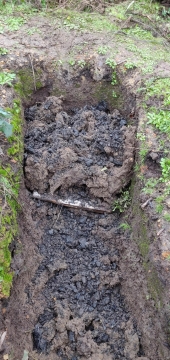The foot paths are filling up and holding water? Not running like streams and eroding the edges of the beds? And holding water for how many days? I don't know how often you are getting rain, so "until the next rain" doesn't mean much to me

Your description makes it sound as though the paths are pretty much on contour, otherwise the water would be flowing, not standing, right?
I don't think putting them on contour would help the condition you are finding, since swales on contour hold water.
What is your soil like? I am going to guess it has a fair bit of clay, or you would have faster infiltration. What is it like 18 inches below the surface? Wondering if you can get down through the clay (or possibly just compaction, depending on history of the site) to a subsoil that will allow better drainage.
If the subsoil is something of a looser, more readily draining variety, then taking a broadfork, or just a breaker bar, to the paths and punching some holes down to that layer would probably help a great deal.







